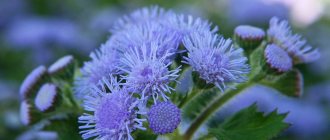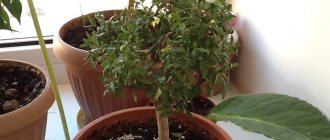The name of a tropical flower grown in gardens and on windowsills, ginura, translates as “woman with a tail.” It's all about the interesting shape of the leaves: it is very reminiscent of the train of a luxurious evening dress. The second common name is bluebird. It was given for the purple or blue tint of the veins. Children sometimes call it crocodile because of the jagged shape of its leaves.
Ginura is a flower from Asia and Africa, part of the large family of Compositae (Asteraceae). Its young stems grow straight up and then droop under their own weight. They are easy to give the desired shape, which is used when creating artistic garden compositions - arches, pergolas, etc. The quadrangular stems stretch up to 1 m in length. The pubescence of the leaves can be violet, lilac, as well as purple and violet.
Ginura
Over time, the branches acquire lateral shoots, thanks to which the bush acquires a lush, elegant appearance. The oval or triangular leaves grow on short petioles one after another. The roots have the largest foliage (up to 20 cm long), and become very smaller towards the ends of the shoots. The edges of the leaf blade are jagged and the surface is velvety. The underside is usually reddish.
Botanical description of ginura
In the genus you can find subshrubs and perennial herbs. Shoots grow vertically at a young age, but over time they take on a horizontal position. At home, it can be grown as an ampel plant in hanging pots.
Thanks to its exotic coloring, it received the names: “woman with a tail” and “blue bird”.
"Woman with a Tail"
Drooping stems can be up to 1 m long. Thanks to the lateral shoots that form on the branches, the bush looks thick and attractive.
The oval oblong leaves are attached to the stem with short petioles. The location is another thing. The leaf blades are larger at the bottom and smaller at the top.
On the underside of the dark green leaves there is pubescence, brightly colored violet, lilac or purple. The leaf margins and central vein also have cilia.
Blue bird - interior decoration
At the beginning of December, ginura is covered with a scattering of flowers, the petals of which are colored orange, purple, green, and red. Flowering continues until the month of May.
If favorable conditions are created, ginura flowering can continue all year round.
The flowers are arranged in corymbose inflorescences and have the shape of a ball. During flowering, the bush emits a charming aroma. But not all gardeners like this smell. Therefore, as soon as buds appear on the bush, plant owners tear them off and enjoy the beauty of exotic foliage.
Bluebird in bloom
In place of the flowers, seed boxes appear. Fluffy tails are clearly visible at the end of each of them. The herbaceous plant is easily propagated by seeds.
Bloom
Ginura blooms profusely from spring to late autumn. The flowering period also depends on the species - there are varieties that bloom in winter. Its small double flowers have shades from yellow to orange.
Flowering weakens the ginura and worsens its appearance . In addition, the flowers emit a strong unpleasant odor, so most gardeners tear off the buds.
Types and varieties of ginura: photo gallery
Ginura
There are 50 species of gynura in their natural habitat. Not many have taken root at home.
Ginura variegata
The beauty of the soft pink leaves of Ginura variegata attracts the eye
Ginura variegata The bush has unusual foliage, which is light pink when young, and with age, dark green spots appear on the leaf blades. Also, with age, the delicate light pink color remains only along the edges of the lower leaves located at the base.
Ginura ascending or Ginura climbing (scandens)
Yellow flowers look spectacular against the background of purple-brown foliage
Ginura ascending or Ginura climbing (scandens) Very rarely found in nature and is represented by a subshrub. The toothed leaves of the petiolate leaves are arranged alternately on the stem. Along the leaf, on both sides of the central vein, there are beautiful stripes of bright green color. The purple-brown leaves have small teeth along the edges.
Orange ginura (aurantiaca)
The narrow petals of the orange ginura are painted golden.
Orange ginura (aurantiaca) The distribution area of the evergreen shrub is the island of Java. The bluish-green ovate foliage is covered with purple cilia. Along the edge of the leaf blades there are teeth, the length of which varies significantly. The inflorescences-baskets contain small golden flowers.
Ginura pinnatifaris
Original coloring of Ginura pinnateris
Ginura pinnatifarisa This species is considered medicinal and is listed in the Red Book. In its natural habitat it grows in the southern regions of China. The shoots are long and hanging. The oval leaves are bright green in color. During flowering, the plant produces a long peduncle, on which beautiful red-orange flowers in the shape of a ball bloom.
Ginura wattle (sarmentosa)
A common species in indoor floriculture
Ginura wattle (sarmentosa) Miniature bright green leaves of the wattle variety are densely covered with long lashes, pubescent with lilac cilia. The length of the shoots is maximum 60 cm. It blooms with yellow or orange flowers.
Some facts
First, a few words must be said about Mr. Grigoriu. Dr. Kostas is a general practitioner, endocrinologist with many years of experience. He studied in the USSR a long time ago, speaks excellent Russian, and today has extensive practice in Cyprus.
First of all, the doctor notes: when talking about ginura, we are not dealing with a medicine, but with a food product that has pronounced healing properties.
Ginura with salmon. A dish on the menu of the ZEN Room restaurant
Fresh ginura The plant has no side effects, and the main healing qualities are a pronounced anti-inflammatory property and an antioxidant effect .
The human body always contains free oxygen radicals that can destroy the cells of our body. This is one of the main causes of aging. Ginura binds free radicals, significantly weakening their effect on the body - this is the antioxidant effect. This determines the effectiveness of ginura for diabetes , as well as its powerful anti-inflammatory effect .
Gynura is able to rejuvenate the skin and internal organs, hence the name: “ longevity spinach ”.
During the observation period, more than 100 patients of Dr. Costas tried to take the plant, and Ginura never failed. No side effects were identified.
Ginura tea
Fresh leaves of ginura and tea made from dried leaves were consumed by patients with diabetes , hypertension and patients suffering from high cholesterol . Fresh ginura leaves - 6-7 pieces - are taken daily in the morning on an empty stomach. It is recommended to take tea from the dried leaves of the plant twice a day - a glass one hour before meals. Ginura has proven itself to be excellent.
Patients suffering from diabetes significantly reduced the dose or completely stopped taking medications that normalize blood sugar levels . Those who regularly took insulin consistently reduced their injection dose while using Gynura.
Ginura: flower care at home
Ginura flower (bluebird)
If the conditions are met, the plant will willingly grow, branch and delight the grower with beautiful flowers, albeit with a specific smell.
Optimal lighting
Ginura flower
To preserve the decorative appearance of the foliage, you will have to choose a place where the plant would feel just fine. With a lack of light, the color of the leaves fades. It’s good if it is possible to place a flower pot near a south-facing window or on a western-facing window sill. In the hottest sunshine, the ginura will have to be shaded from the scorching rays of the sun.
In winter, the plant does not have enough natural light, so it will have to be illuminated with fluorescent lamps.
Selecting soil for planting
Exotic bluebird fire flower
For cultivation, you can take soil prepared at home.
Soil composition:
- turf soil - 2 parts
- humus - 2 parts
- sand – 1 part
- leaf soil - 2 parts
The flower will feel good in purchased soil. The main criteria when choosing soil are: good breathability, looseness and neutral reaction.
Before planting, add a layer of expanded clay to the bottom of the pot. This is a prerequisite for successful cultivation.
Temperature
Ginura at home
During the growing season, it is necessary to maintain a temperature of +18-23°C. You cannot place a pot with ginura in a place where drafts cannot be avoided. In winter, if there is no additional lighting, the bush is kept in a cool room with a temperature of +12-13°C. Thus, the plant is at rest and gaining strength.
Watering rules
In the summer, go to the garden!
The intensive growth of the plant requires abundant watering, which is carried out after the earthen clod has dried out. The roots should not be allowed to remain in soil that is too wet all the time. The plant needs moderate watering.
Insufficient watering leads to wilting and drying of the leaves. The lashes become sluggish and then it is very difficult to restore their turgor.
When kept in a cool room, during the dormant period, the plant must be watered as needed, avoiding prolonged drying out of the soil. And excessive watering will lead to rotting of the roots.
It is best to water with soft, settled water, which should not come into contact with the velvety foliage during watering.
Humidity
Ginura flowers
The plant is unpretentious to air humidity, but does not tolerate excessive dryness. In winter, due to the hot air emanating from heating devices, the ginura may need additional humidification.
You should know that decorative foliage cannot be sprayed. Spraying will have to be abandoned. To increase humidity, it is recommended to place the plant pot on a tray with pebbles and moisten them from time to time.
Pruning rules
Ginura
In early spring, when the plant's dormant period ends, it is recommended to shorten the long lashes. The procedure is performed to make the bush decorative. Forming a crown is a simple procedure that only involves pinching the shoots.
Fertilizer application
Ginura
Feeding is carried out throughout the growing season once every 2 weeks. Fertilizers cannot be applied during the dormant period.
How to carry out a transplant correctly?
The plant is grown in the most illuminated place
Transplantation is carried out as needed. It is advisable to postpone all work until spring. However, if the cultivation takes place under additional lighting, the plant can be replanted in the fall.
Annual rejuvenation of the plant is recommended, since the beauty of the velvety leaves loses its attractiveness with age. Or the plant needs a garter.
Transfer
Frequent transplants for ginura are a necessity, but there is no point in establishing the frequency according to certain recommendations. It's better to do it as needed. Once the roots completely fill the pot, it’s housewarming time. Sometimes the plant does not grow well, in which case it can be left until next spring. Early spring is the optimal time for transplantation. The level of the root collar is left at the same level, increasing the volume of the pot and not forgetting the need for a wide drainage layer.
Reproduction methods
The cuttings have taken root and can be transplanted into a substrate of shade
There is nothing complicated about reproduction. Cuttings are the simplest method of obtaining new specimens. Any apical cutting taken from the mother plant will certainly sprout roots.
You can first cut the long stem and then cut it into cuttings. They will all take root, despite the fact that most of them will not have a top. New sockets will appear in the sinuses.
You can root in water. After a week you can already admire the roots.
A few words about the ginura that grows in me
My jinura arrived from Cyprus about six months ago, in August. She stood on the windowsill for a long time, nothing special happened. Then, around October, I transplanted it. And she was surprised that it existed for so long and did not die, since the soil was contaminated with various insects. After the transplant, the ginura immediately began to grow. Here you can observe the changes that happened to her after a month. I didn’t think to take photos immediately after transplantation, so I’ll note: the lighter parts of the plant are those that grew within a month (October-November):
When I was going to replant the ginura, I could not find information on the Internet about what its roots were. Since I didn’t think to take photographs of the transplant, I’ll try to explain it in words. The root system consists of a large number of roots, similar to long threads; there are no hard roots. I think pots that are too large for a mature plant are not necessary. Mine was five liters, I took more, not knowing what awaited me. I used regular flower soil, with the obligatory layer of drainage at the bottom. You need to water as soon as the soil dries, and periodically loosen the soil. Naturally, the plant is from the south - it will not grow outside in winter)), but ordinary room temperature is quite suitable. One more nuance: after the transplant, my ginura stood in a dark place, the result is shown here in the photo:
Weakened, thin, bleached stems and leaves, ginura reacts sharply to a lack of light. Therefore, in winter, additional lighting with special phytolamps is needed. I have a full-spectrum lamp, adapted for use in a residential area (this is a very important point - not all phytolamps can be installed in a residential area):
2.5 weeks after installing the lamp:
Separately, I will say a few words about pruning and planting cuttings. I cut it as low as possible:
I root in a regular glass of water. On the cuttings themselves I leave a few leaves at the top and tear off the rest; my cuttings should not be tall. All this is due to the fact that ginura grows very quickly, can grow up to a meter high, and bushes well if pruned. Photos of cuttings:
A week and a half to two weeks after planting, these cuttings will need to be pruned again. Regarding fertilizers, I found recommendations that ginura tolerates only mineral fertilizers. I used Agricola Fantasy fertilizer once and did not notice any changes.
As for my personal use of ginura. I can testify that an improvement in well-being is observed immediately, from the first days. So far my “plantation” is not large enough for regular use, so I can’t say anything about the results of long-term use of ginura. I want to make it clear right away: these are not rejuvenating apples or the living water from fairy tales, but it is quite an effective remedy, and without side effects. And let me remind you: in any case, no one canceled the doctor’s recommendation. My article will not replace it, I’m just sharing my experience!
Be healthy!
PS Now you have the opportunity to purchase ginura for yourself. The weather is favorable, and the ginura has grown, so I invite you to look at the product pages:
Living plant in a pot Gynura Procumbens
And
Seedlings Ginura Procumbens
Growing problems: pests and diseases
Ginura
Insufficient care of the plant can lead to dire consequences. Ginura may become sick, or various insects may appear on its decorative foliage. Depending on the season, you can see different pests on the plant. If any are found, you will have to immediately carry out treatment to save the plant from death.
Shields
Shields
Scale insects are small insects with an oblong body covered with a chitinous shell. By sticking to the shoots, scale insects suck out the juice from the foliage. As a result of their vital activity, the leaves turn yellow and fall off. The plant stagnates and slowly dies.
To combat the pest, you can use Actellik. To get rid of the insect, double treatment is necessary.
Mealybugs
Mealybugs
Mealybugs Settling on a plant, they feed on its sap.
They got their name due to the fact that as a result of their life activity they leave a cotton-like discharge on the leaves and stems.
The plant begins to hurt, growth stops, the leaves turn yellow, and over time it may die.
Some types of parasites cause damage to the root system. For control they use the insecticides Fitoverm, Aktaru, Calypso.
Spider mite
Spider mite
Spider mite When examining the plant, you can notice small white dots on the underside of the leaves, and a thin cobweb may be woven around the lashes.
Unlike other parasites, spider mites are carriers of infections. If a plant gets sick with viral diseases, it will be easier to dispose of it than to cure it.
All means are good for pest control. In addition to chemical remedies, folk remedies help. You can fight with garlic infusion and avoid excessive dry air. As for industrial preparations, it is recommended to use Fitoverm, Actellik, Fufanon.
Whitefly – crown pest
Whitefly
Whitefly Most often appears on plants in summer. Small white-winged insects enter the house from the street through an open window. Whiteflies lay their eggs on the underside of leaves.
The fight is quite simple. You need to go to a specialized store and purchase one of the drugs: Mospilan, Actellik, Fitoverm.
Story
In sunny, distant Cyprus, about 10-15 years ago, the first plantation of one amazing plant appeared. And she was a success. Around this time, official science, in particular in Cyprus, Malaysia, Singapore, etc., began to actively study the exceptional possibilities of what has been successfully used in Eastern traditional medicine, in particular, in Tibetan and Japanese medicine for several hundred years. Thanks to this interest, we now have an evidence base confirming that it is not for nothing that people call some quite ordinary, at first glance, plant “leaves of God.” So, get acquainted: the topic of our article today is a rather ancient plant called “ginura procumbens”. Under natural conditions it lives in Cyprus, in the countries of Southeast Asia, and is widespread in the latter. The plant is edible and used as a regular salad. For example, in Cyprus, where it appeared not so long ago, ginura has already settled in local restaurants. Those. It’s quite possible to order a salad or drink with ginura.
The first mention of ginura, or rather, of its ancestor, is found in the works of Dioscorides Pedanius, a Roman physician, one of the fathers of botany, in the section on medicinal plants of the Mediterranean (1st century AD). West Africa is considered the homeland of jinura, then it was brought by sea to the countries of Southeast Asia, Japan, China, where it firmly established itself. Today, there are many studies confirming the real therapeutic effect in the fight against serious diseases; ginura is included in many reference books of medicinal plants.
Ginura in the house: signs and superstitions
Ginura in the house
In indoor floriculture, mainly poisonous species are grown. In their natural habitat, you can find some varieties that are considered medicinal.
Beneficial features
Cirrus ginura
Cirrus ginura is quite expensive and is considered a rare medicinal plant. In a province located in China, they are breeding this species for the purpose of selling medicinal raw materials.
The medicinal properties of procumbens are familiar to residents of Japan, America, Africa and China. They know firsthand about its healing properties. Eating leaves every day strengthens the immune system, a person does not know diseases.
Signs
Ginura in nature
Due to this peculiarity of flowering, that the flowers of the exotic plant emit unpleasant incense, it is popularly nicknamed “crocodile”.
If you place a flower in your home, you don’t have to worry about bad energy. The Scorpio plant copes well with this. A phrase like: “Sleep improves with a blue bird” actually has a good meaning. Indeed, it has been proven that keeping any type of ginura in the house improves the quality of sleep and prevents nightmares.
Parents whose children are afraid of the dark should definitely have a ginura in the house.
Many people with a harsh character become kinder, since soft velvety leaves are able to calm a formidable temper.
And most importantly, ginura is a flower that leads to female happiness.
Ginura care is quite simple. By following simple agricultural practices, you can get a well-branched bush of velvety beauty with soft and pubescent leaves. You can learn how to care for ginura at home from the video below.
VIDEO: Ginura – Flower Shop
GINURA | An unpretentious plant from the ASTER family | Care and breeding at home
Ginura - care at home: planting and pruning, growing conditions, methods of reproduction. Signs and medicinal properties | (70+ Photos and Videos)
Medicinal properties
Indoor ginura is poisonous and it is strictly forbidden to take it internally. But other plant species also grow in the wild, from which valuable and very expensive medicines are extracted. For example, in one of the provinces of China they use pinnately cut ginura for this, and in America - prostrate.
The leaves of these medicinal species can simply be added to salads to improve well-being, reduce blood pressure and lose excess weight, as well as to cleanse the body.
Be sure to make sure that this wonderful plant with lush green leaves framed in purple appears in your home collection. And if you want, you can always get rid of foul-smelling flowers.
Bibliography:
1. Jeong-Hwa Han, Hye-Jin Lee, Tae-Seok Kim. // The effect of glutathione S-transferase M1 and T1 polymorphisms on blood pressure, blood glucose, and lipid profiles following the supplementation of kale (Brassica oleracea acephala) juice in South Korean subclinical hypertensive patients // Nutr Res Pract. // Feb, 2015. 9(1) 2. American Diabetes Association. // Lifestyle Management: Standards of Medical Care in Diabetes—2019. // Diabetes Care // Jan, 2022. 42 3. Betsy B. Dokken. // The Pathophysiology of Cardiovascular Disease and Diabetes: Beyond Blood Pressure and Lipids. // Diabetes Spectrum // Jul, 2008. 21(3) 4. HS Ejtahed, J. Mohtadi-Nia, A. Homayuni-Rad. // Effect of probiotic yogurt containing Lactobacillus acidophilus and Bifidobacterium lactis on lipid profile in persons with type 2 diabetes. // Dairy Sciences // July, 2011. 94 (7) 5. V. Vuksan, Jenkins, C. Brissette. // Salba-chia ( Salvia hispanica L.) in the treatment of overweight and obese patients with type 2 diabetes: a double-blind randomized controlled trial // Nutrition, metabolism and cardiovascular disease // February, 2022. 27(2).
No. 7. Berries
These are valuable sources of antioxidants that suppress oxidative stress. And this is one of the possible causes of heart disease and some types of cancer pathologies.
A report published in 2008 provided evidence that people with diabetes have chronic levels of oxidative stress. And it occurs when there is an imbalance in the body between antioxidants and unstable oxygen molecules - free radicals.
The diet should include: blackberries, strawberries, raspberries, etc. These berries contain a large number of antioxidants, fiber, and also:
- vitamin C and K;
- manganese;
- potassium











